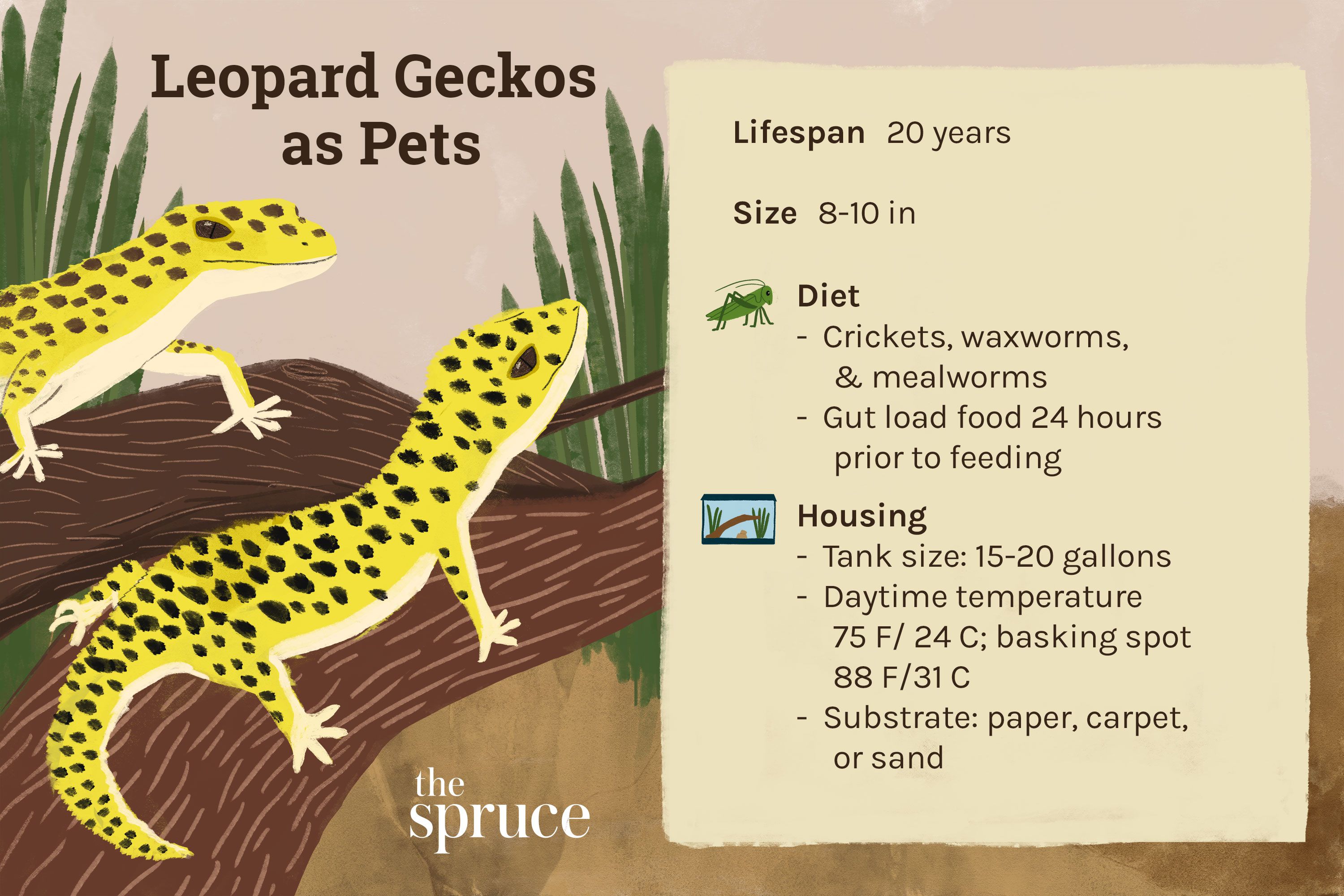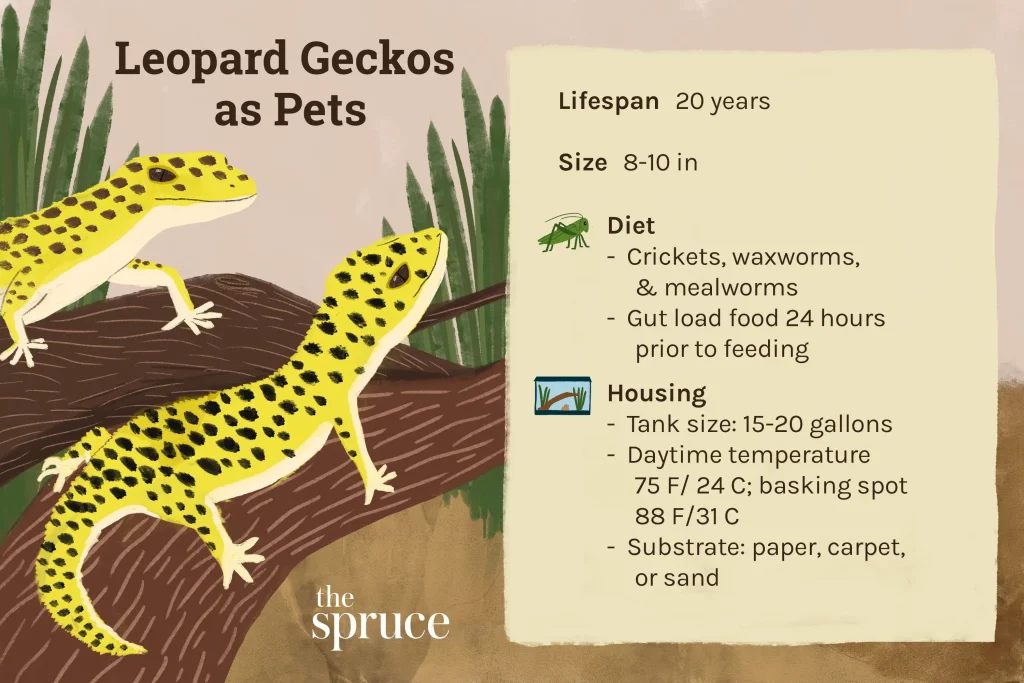Leopard geckos are fascinating creatures that make great pets. However, many people are hesitant to take on the responsibility of caring for one, wondering if it is too difficult. The truth is, while there are some specific requirements for their care, leopard geckos are not hard to take care of with a little knowledge and preparation.
First and foremost, leopard geckos are low maintenance animals that do not require a lot of attention. They are also fairly easy to feed and their enclosure can be set up relatively easily. However, it is important to understand their specific needs in terms of lighting, temperature, and diet to ensure they stay healthy and happy. With the right information and preparation, anyone can successfully care for a leopard gecko.
Leopard geckos are relatively easy to take care of, making them a popular choice for first-time reptile owners. They require a properly sized enclosure with a heat source, a substrate for bedding, a water dish, and a balanced diet of live insects. It is important to regularly clean the enclosure and provide proper lighting. With proper care, leopard geckos can live up to 20 years in captivity.

Are Leopard Geckos Hard to Take Care of?
Leopard geckos are fascinating creatures, and they make great pets for those who are interested in reptiles. They are relatively easy to care for, but there are a few things that you need to keep in mind if you want your leopard gecko to thrive. In this article, we will discuss the various aspects of leopard gecko care and answer the question: Are leopard geckos hard to take care of?
Environment
Leopard geckos are native to the deserts of Pakistan, Afghanistan, and India. As such, they require a warm, dry environment that mimics their natural habitat. You will need to provide your leopard gecko with a terrarium that is at least 20 gallons in size. The terrarium should have a secure lid to prevent escape and should be lined with a substrate that is easy to clean and doesn’t hold moisture.
The temperature inside the terrarium should be maintained between 85 and 90 degrees Fahrenheit during the day, with a cooler area (around 75 degrees) for the gecko to retreat to if it gets too hot. At night, the temperature can drop to around 70 degrees. You will need to provide a heat source (such as a heat lamp or under-tank heating pad) to maintain the proper temperature.
You will also need to provide your leopard gecko with hiding places and climbing structures. These can be purchased at a pet store or made from materials such as rocks, logs, and PVC pipe.
Diet
Leopard geckos are insectivores, which means that they eat insects. You will need to provide your gecko with a variety of insects, such as crickets, mealworms, and waxworms. You can purchase these insects at a pet store or online.
It is important to provide your gecko with a balanced diet. You can do this by dusting the insects with a calcium and vitamin D3 supplement before feeding them to your gecko. You should also provide a shallow dish of water for your gecko to drink from.
You should feed your gecko every day or every other day, depending on its age and size. Young geckos will need to eat more often than adult geckos.
Health
Leopard geckos are generally healthy animals, but they can develop health problems if they are not properly cared for. One common health problem is metabolic bone disease, which is caused by a lack of calcium and vitamin D3 in the gecko’s diet. This can lead to weak bones and muscle spasms.
To prevent metabolic bone disease, you should provide your gecko with a calcium and vitamin D3 supplement and a UVB light. The UVB light will help your gecko produce vitamin D3, which is necessary for the absorption of calcium.
You should also watch for signs of illness, such as lethargy, loss of appetite, and diarrhea. If you notice any of these symptoms, you should take your gecko to a veterinarian who specializes in reptiles.
Cleaning
Keeping your leopard gecko’s terrarium clean is important for its health and well-being. You should spot clean the substrate every day, removing any feces or uneaten food. Once a month, you should do a deep clean of the entire terrarium, removing everything and cleaning it with a reptile-safe cleaner.
You should also replace the substrate every three to four months, or more often if it becomes soiled.
Benefits of Owning a Leopard Gecko
Leopard geckos make great pets for a number of reasons. They are relatively low maintenance, and they don’t require as much space as some other reptiles. They are also very docile and can be handled without fear of biting or scratching.
Leopard geckos are also fascinating to watch. They are nocturnal, which means that they are most active at night. Watching them hunt and eat their prey is both entertaining and educational.
Leopard Geckos vs. Other Reptiles
Compared to other reptiles, leopard geckos are relatively easy to care for. They don’t require as much space as some other reptiles, and their diet is simple and easy to provide. They are also very docile and can be handled without fear of injury.
However, leopard geckos are not the best choice for everyone. They are nocturnal, which means that they are most active at night. If you are looking for a reptile that is active during the day, a leopard gecko may not be the best choice.
Conclusion
In conclusion, leopard geckos are not hard to take care of, but they do require a certain level of attention and care. You will need to provide them with a warm, dry environment, a balanced diet, and regular cleaning. If you are willing to put in the effort, a leopard gecko can make a great pet that will provide years of enjoyment.
Frequently Asked Questions
Are Leopard Geckos Hard to Take Care of?
Leopard geckos are generally easy to take care of, making them a popular pet choice. However, as with any animal, they do require some specific care to ensure their health and well-being. One of the most important aspects of caring for a leopard gecko is providing the proper habitat. They need a tank that is at least 10 gallons in size, with a heat source, hiding spots, and a substrate that is easy to clean. Additionally, they require a specific diet of live insects, such as crickets and mealworms, as well as a calcium supplement.
While leopard geckos may not be difficult to care for, they do require regular maintenance. Their tank must be cleaned regularly, and their diet needs to be monitored to ensure they are getting enough nutrients. They also require regular handling to ensure they remain socialized and comfortable with human interaction. Overall, leopard geckos are a great choice for first-time reptile owners, but they do require some effort and attention to ensure their health and happiness.
What Temperature Should a Leopard Gecko’s Habitat Be?
Leopard geckos are native to warm, arid regions, so it’s important to provide them with a habitat that mimics their natural environment. The ideal temperature range for a leopard gecko’s habitat is between 88-92 degrees Fahrenheit during the day, with a cooler area around 75-80 degrees Fahrenheit for them to retreat to. At night, the temperature can drop to around 70 degrees Fahrenheit. It’s important to use a thermostat to regulate the temperature and prevent it from getting too hot or too cold.
Maintaining the proper temperature range is essential for a leopard gecko’s health and well-being. If the habitat is too cold, they may become lethargic and have trouble digesting their food. If it’s too hot, they can become dehydrated and suffer from heatstroke. Regularly monitoring the temperature and making adjustments as needed is important to ensure your leopard gecko remains healthy and happy.
How Often Should I Feed My Leopard Gecko?
Leopard geckos require a specific diet of live insects, such as crickets and mealworms. The amount and frequency of feeding will depend on the age and size of your gecko. Younger geckos may need to be fed more frequently, while adult geckos may only need to be fed every other day. It’s important to monitor your gecko’s weight and adjust their feeding schedule as needed to ensure they are getting enough nutrients.
In addition to live insects, leopard geckos also require a calcium supplement to maintain their bone health. This can be provided in the form of a dusting powder on their food. It’s important to ensure that the insects are gut-loaded, meaning they have been fed a nutritious diet before being fed to your gecko. Providing fresh water in a shallow dish is also important for their hydration.
Do Leopard Geckos Need UVB Lighting?
While some reptiles require UVB lighting to synthesize vitamin D3, leopard geckos do not. They are primarily nocturnal and do not require UVB lighting to thrive. However, providing a low-wattage incandescent bulb or ceramic heater can help maintain the proper temperature range in their habitat.
While UVB lighting may not be necessary for leopard geckos, providing a regular day-night cycle is important for their health and well-being. Keeping their habitat on a consistent schedule will help regulate their behavior and ensure they receive proper rest.
Can Leopard Geckos Live Together?
While leopard geckos are social animals, they are also territorial and can become aggressive towards each other. It is not recommended to keep multiple leopard geckos in the same habitat, as they may fight and injure each other. It’s important to provide each gecko with their own habitat and ensure they have plenty of space to move around and explore.
If you do want to keep multiple leopard geckos, it’s important to house them separately and only allow supervised interaction. It’s also important to ensure that each gecko has their own food and water source, as well as hiding spots to retreat to. In general, it’s best to avoid housing multiple leopard geckos together to prevent potential conflicts.
How NOT to Care for Leopard Geckos – Common Mistakes!
In conclusion, leopard geckos are not as hard to take care of as many people may think. With the right setup and proper care, they can be great pets for both experienced and novice reptile owners.
Firstly, providing a suitable environment for your leopard gecko is crucial. This includes a spacious enclosure with proper heating and lighting. Additionally, offering a variety of hiding spots and a shallow water dish will ensure their comfort and well-being.
Secondly, feeding your leopard gecko a proper diet consisting of live insects and occasional supplementation will help maintain their health. It is important to do research and consult with a veterinarian to ensure your gecko is receiving the necessary nutrients.
Lastly, regular cleaning and maintenance of the enclosure will help prevent any potential health issues and keep your leopard gecko happy and healthy.
Overall, while there is some effort involved in caring for leopard geckos, it is manageable with proper research and attention. They can make wonderful and fascinating pets for those willing to provide the necessary care.


